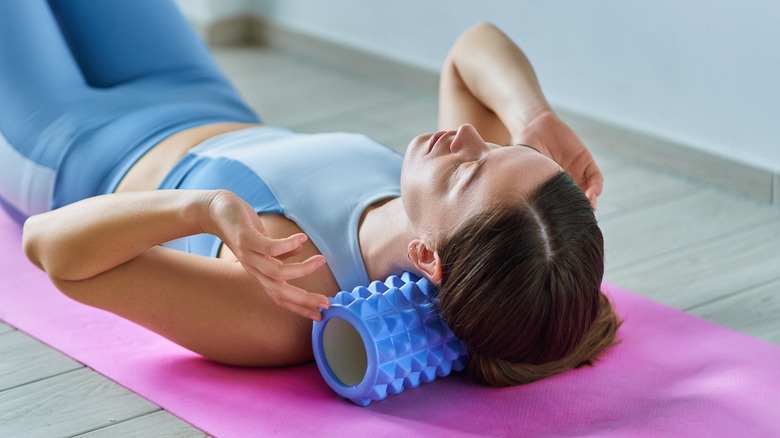Turns Out We Have A Button To Stop Nagging Neck Pain. Here's How To Find It
Sitting at a desk for a while can easily turn into a literal pain in the neck. It might not be noticeable while you're in deep work mode, but you feel that stabbing pain when you sit back for a break. You move your head back and forth and wish a massage therapist was sitting close by.
It shouldn't be a surprise to know that your shoulders and neck hold a lot of the frustration and resentment in your life, according to Five Element Acupressure. Traditional Chinese Medicine believes that the body has more than 2,000 acupoints in the body that correspond to specific meridians. If your energy, called qi, gets blocked along one of these meridians, this imbalance can cause certain ailments.
The gallbladder meridian is one of these 12 meridians that run through your body, with 44 gallbladder acupoints running from your foot to your shoulder. An imbalance in your gallbladder qi can cause a lack of confidence, poor judgment, and muscle pain (per Healthline). When someone massages your shoulders and presses on the Jian Jing acupoint of the gallbladder meridian, you probably feel all this tension in your neck and shoulders melt as the qi begins moving again. Releasing the stuck qi in this region also opens up your arms to initiate action in your life (per Five Element Acupressure).
Find the Jian Jing and Feng Chi acupoints
The Jian Jing or Shoulder Well acupoint can stop your nagging neck pain because it's located halfway between your neck and shoulder. If you place your first three fingers on your shoulders so your ring finger is at the base of your neck, you've found the Jian Jing with your index finger. You can also pinch your upper trapezius muscle to stimulate gallbladder qi and relieve pain in your neck and shoulders (per Turning Point Acupressure).
The Feng Chi pressure point is also known as the Wind Pool. You can find this acupressure point by clasping your fingers and placing them at the crown of your head with your thumbs pointing down just behind your ears. Using your thumbs, feel the bone of your skull, then move your thumbs further behind your neck until you feel a small hollow before you reach the neck muscles (per Katoka Massage Therapy). Applying pressure to the Feng Chi acupoint can also help with insomnia.
How to do acupressure on yourself
You can perform acupressure while sitting in your office, but try to find about 10 or 15 minutes where you can be undisturbed. Sit or lie down in a comfortable position with a soft gaze downward. You can also close your eyes. Your thumbs or fingers can apply pressure in a circular motion, but you might find a tennis ball or massage tools to help stimulate these points (per Kaiser Permanente). Some neck pillows and cushions have acupressure knobs or plastic nodules to stimulate qi flow.
You can also apply five seconds of pressure five times, several times a day. Applying acupressure to these points where qi might be blocked activates the nerves and sends calming signals to your brain. This relaxes your muscles and stimulates blood flow. You might also notice your body releasing soothing endorphins (per Kanjo). Although Western medicine hasn't found evidence of these meridians, a 2019 article in Evidence-Based Complementary and Alternative Medicine said that the meridians could be linked to the connective tissue that runs through the body.



